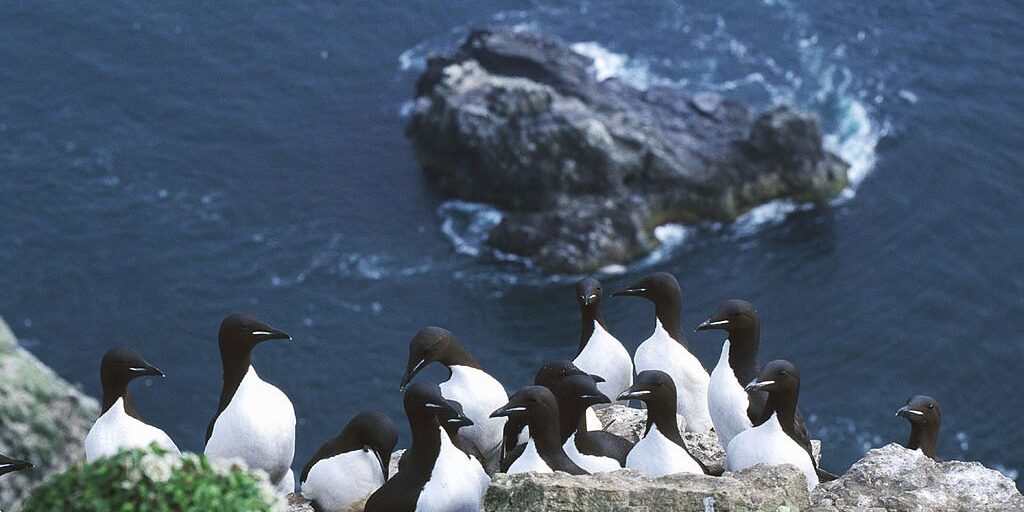The exact cause of the 2018 seabird die-off, that affected more than a thousand birds in the Bering Strait region, is still unknown. However, scientists with the U.S. Fish & Wildlife Service (USFWS) believe it is not related to a strain of Avian flu that was found in two seabirds, which is at odds with prior theories from a researcher at the University of Alaska Fairbanks.
KNOM’s Davis Hovey has more:
According to Kathy Kuletz, the seabird section coordinator for USFWS in Alaska, 26 carcasses from the 2018 die-off were sent to them for sampling. Those seabirds were then transferred to the USGS National Wildlife Health Center in Madison, Wisconsin.
“Some of them were not in real good shape when they (USGS) got them, but they were able to determine that 14 died of starvation, they were highly emaciated. One died from some kind of trauma and two they couldn’t determine. All of those were tested for Avian influenza. Two of those came back positive.”
The two birds that tested positive for Avian influenza were a kittiwake from Wales and a thick-billed murre from Savoonga. That thick-billed murre was the exact same bird a University of Alaska Fairbanks researcher came across during her studies on St. Lawrence Island in 2018.
“Of course birds were starving, so that may have been poor foraging ability, that may have been a result. But we’re looking a little bit more at ‘maybe they were sick.’”
– Alexis Will
Alexis Will is a researcher with UAF’s Institute of Arctic Biology. Will recently explained how she and her fellow researchers found no evidence thick-billed murres experienced food shortages in 2018. And she cited the thick-billed murre from Savoonga with Avian influenza as an indicator that the cause of the die-off from 2018 could be due to disease and not food related.
U.S. Fish & Wildlife Service (USFWS) disagrees.
“Both H10N6 viruses and H16N3 viruses (Avian flu) have previously been detected in apparently healthy birds. And again, none of these previous detections have been associated with die-off events.”
– Andy Ramey
Andy Ramey is a research geneticist with USGS’ Alaska Science Center. Based on his more than ten years of studying Avian influenza, and previous scientific findings, Ramey is skeptical that the bird disease caused the 2018 die-off. USFWS is doing more tests and studies to confirm that disease like the Avian flu did not cause this large-scale event to happen.
Meanwhile, Ramey, Kuletz and fellow USFWS seabird biologist Robb Kaler, believe there are other factors contributing to hundreds of birds starving and dying in the Bering Strait region. Those include record warm ocean temperatures, lack of sea ice, and the absence of a cold-water barrier in the Bering Sea from 2018.
“So with the warm water and the lack of sea ice, that’s going to affect the metabolism of both the predator, in this case the seabird, and the prey, whether it’s krill, euphasids or forage fish. But that warm water could also affect the abundance and distribution of that prey.”
– Robb Kaler
Although the scientists acknowledge there is still food available for seabirds to eat near St. Lawrence Island, and in the Bering Sea, their prey base is changing and may not be as nutritious as normal. Kaler refers to these types of fish as “junk food.”
“Capelin are very rich in nutrients versus pollock or cod, juvenile cod or pollock, being brought to the nests of a thick-billed murre. Capelin are king and there’s a junk food hypothesis about less nutritional…so the parent has to work harder to provision the nest if they’ve got junk food that they’re bringing back to their chick.”
With ecosystem-wide changes underway in the Bering Sea, USFWS isn’t ruling out food-related causes of death or that there were potential effects of Avian influenza or Harmful Algal Blooms (HABs).
The agency is, however, emphasizing that the 2018 seabird die-off in the Bering Strait region was most likely not associated with Avian influenza. Ramey also points out that emaciation is not a clinical sign of influenza in birds, and many of the seabirds they sampled were found to be emaciated.
According to Kaler, they anticipate another seabird die-off will be seen in the Bering Sea this summer while USFWS works to solve the mystery of the 2018 event. If the Bering Strait region experiences another large-scale dieoff this year, that would be the sixth year in a row featuring mass seabird deaths.
Image at top: A group of seabirds (murres) nesting in the cliffs. Photo from the public domain, via Wikimedia Commons.




